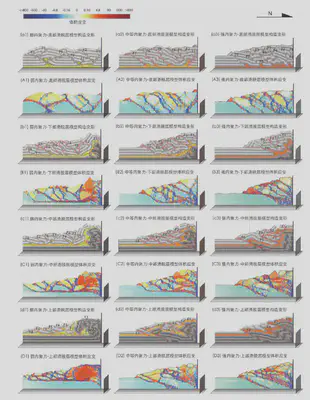Study on the Control Factors of Structural Deformation in the Southwestern Tianshan Piedmont Thrust Belt Based on Discrete Element Numerical Simulation
Paper Download:
Title: Study on the Control Factors of Structural Deformation in the Southwestern Tianshan Piedmont Thrust Belt: Based on Discrete Element Numerical Simulation
Author:Wen Xin
Abstract
The deformation of the eastern and western segments of the fold-thrust belt in the southwestern Tianshan Piedmont is significantly different. The Kashgar northern margin thrust belt in the western segment is characterized by the development of “stacked” structures and basement-involved thrust structures, while the adjacent Kalpin thrust belt in the eastern segment develops large-scale imbricate thin-skinned detachment structures. What factors control the deformation differences in the thrust belt? Based on seismic interpretation profiles, this thesis uses discrete element numerical simulation to analyze the influence of single-variable controlling factors on the deformation of the thrust belt. A total of 28 experiments were designed to investigate the effects of factors such as detachment layer strength, detachment layer position, caprock thickness, pre-existing faults, single and bidirectional compression, and bidirectional compression distance on the structural deformation of the fold-thrust belt in the southwestern Tianshan Piedmont. The following conclusions were drawn based on the experimental results:
1.The magnitude of the detachment layer’s cohesion plays an important controlling role in deformation. The cohesion of the detachment layer controls the ease with which faults beneath it can propagate upward. When the detachment layer has strong cohesion, it is easy for faults to break through the detachment layer along pre-existing weak zones, forming thrust nappe structures. When the detachment layer has weak cohesion, it will develop into a roof fault of the thrust system, hindering the upward propagation of pre-existing faults activated in the units below the detachment layer. A weak cohesion detachment layer can promote the deformation front to propagate faster and farther; it limits deformation to mainly occur in the units above the detachment layer, where triangular zones and pop-up structures are easily formed, and structural deformation in the units below the detachment layer is relatively weak. The smaller the cohesion of the detachment layer, the easier it is to form imbricate thin-skinned detachment structures; the thicker the overlying strata, the larger the scale and fewer the number of thrust sheets formed, and the greater the spacing between thrust sheets. 2.During single and bidirectional compression, stress and strain are mainly concentrated in weak zones such as detachment layers and faults, with stronger stress and strain near the compression end. The smaller the cohesion of the detachment layer, the easier it is for stress to propagate to distant locations. During close-range bidirectional compression, stress can propagate to the far end through the weak cohesion detachment layer, thereby affecting deformation at the far end. During long-range bidirectional compression, it does not affect deformation on the other side. 3.The Upper Cretaceous-Paleogene gypsum-salt detachment layer and pre-existing faults before the Cenozoic are the main controlling factors for the development of stacked deformation in the Kashgar northern margin thrust belt. At the same time, the northward compression of the Pamir arc tectonic belt has also affected the deformation style of the Kashgar northern margin thrust belt. The Paleogene gypsum-salt layer can serve as an effective detachment layer in the region. During compression, pre-existing faults from the pre-Cenozoic are successively activated and overlap to form a series of thrust sheets. The Upper Cretaceous-Paleogene gypsum-salt detachment layer acts as a roof fault, hindering the continued upward and southward propagation of deep faults beneath it, and forming “stacked” structures near the compression end. The Kashgar northern margin thrust belt is located in the Pamir and South Tianshan suture zone. Its southern front fault is affected by the northward thrusting of the Pamir arc tectonic belt, hindering the southward and upward breakthrough of the hidden thrust fault at the front edge of the Kashgar northern margin thrust belt. As a result, the Kashgar northern margin thrust belt does not form imbricate thin-skinned detachment structures similar to those in the Kalpin thrust belt. 4.The development of large-scale imbricate thin-skinned detachment structures in the Kalpin thrust belt is closely related to the Middle Cambrian gypsum-salt detachment layer and the thick Paleozoic sedimentary caprock. The development of thick Paleozoic and Cenozoic strata in the Kalpin area enhances the effectiveness of the Middle Cambrian gypsum-salt detachment layer as an effective weak cohesion detachment layer. During compression, a series of thrust sheets that converge downward into the Middle Cambrian detachment layer are formed, developing large-scale imbricate thin-skinned detachment structures. In addition, the Kalpin area is far from the West Kunlun-Pamir thrust belt, and its deformation is not affected by the northward compression of the West Kunlun-Pamir thrust belt. Within the Kalpin thrust belt, it is further divided into eastern and western segments bounded by the Piqiang fault. The Cambrian gypsum-mudstone-salt detachment layer in the western segment is buried deeper, with thicker overlying sedimentary strata. In contrast, the Cambrian gypsum-mudstone-salt detachment layer in the eastern segment is buried shallower, with relatively thinner overlying sedimentary strata. As a result, the thrust sheets in the western part of the Kalpin thrust belt are larger in scale, have greater spacing, and are fewer in number than those in the eastern part.
Keywords: Southwestern Tianshan, fold-and-thrust belt, structural deformation, controlling factors, numerical simulation
Contents:
- Chapter 1 Introduction
- Chapter 2 Numerical Simulation Study of Thrust Belts
- Chapter 3 Regional Geological Overview
- Chapter 4 Numerical Simulation Analysis of Deformation Controlling Factors in the Northern Kashgar Thrust Belt
- Chapter 5 Influence of Detachment Layers and Overlying Stratum Thickness on Deformation of the Kalpin Thrust Belt
- Chapter 6 Analysis of Controlling Factors for Deformation Differences between the Northern Kashgar Thrust Belt and the Kalpin Thrust Belt
- Chapter 7 Insights and Conclusions
- References

Deformation-strain results from numerical simulation experiments on the Kalpin thrust belt
Translator: Ouyang Liujuan